How does it stack up against the
competition?
Since its fall 2012 release, the iPad mini
has been a big hit. It quickly sold millions and was a top gift item over the
holiday season. People love the fact that it's thin, light, and more portable,
yet still offers the same user experience as the full-sized iPad.
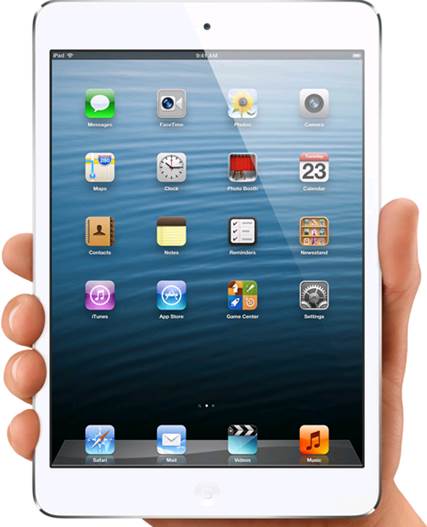
Since
its fall 2012 release, the iPad mini has been a big hit.
The 7.9-inch display gives you a viewing
space that's two-thirds the size of its larger sibling. It has the same screen
resolution, 1024 x 768, as the iPad 2, which means, of course, that all current
iPad apps work on the iPad mini without needing to be rewritten by developers.
It's about as thick as a pencil - just over
a quarter of an inch thick. And it weighs 0.68 lbs - half the weight of the
larger iPad. Even though I'd read a lot about the iPad mini and had watched the
event during which Apple announced it, I was still astonished when I received
mine and felt how thin and light it was.
I have my iPad with me all the time, ever
since I bought the first model in 2010. But frankly, I got a bit tired of
carrying my full-sized iPad, even though I have a great STM bag with a shoulder
strap that perfectly suits my needs. So it's a real convenience that the iPad
mini fits in my coat pocket - and that it's so light I barely notice it's
there. If I do need a shoulder bag, I use STM's bag for the mini, and again,
it's much less cumbersome than before.
The iPad mini includes Siri, a 5-megapixel
camera that shoots 1080p video, and a front-facing 720p HD camera. It starts at
$329 for Wi-Fi-only and 16GB memory. Note that this model does not include GPS.
For an additional $130, you can get a mini that connects to the cellular data
network and has GPS.
If you're still undecided, and keep
wondering whether a different 7-inch tablet might suit your needs better, let's
take a look at the three that seem to be the most popular: those sold by
Amazon, Google, and Barnes & Noble.
Other 7-inch Tablet specs
Amazon Kindle Fire HD
In October 2012, Amazon introduced their
Kindle Fire HD, which has a 1280 x 800 FID display - greater resolution than
the iPad mini. It has Dolby speakers and speedy Wi-Fi for streaming FID movies.
It lacks a rear-facing camera and GPS, but does have a front-facing camera for
videoconferencing. It starts at $199 for 16GB of memory. This has so far been
the second-bestselling tablet. There's no option for purchasing a model that
connects to the cellular data network. Note that because Amazon sells these at
cost, they come with on-screen ads. If you want to dump the ads, it'll cost you
an extra $15.
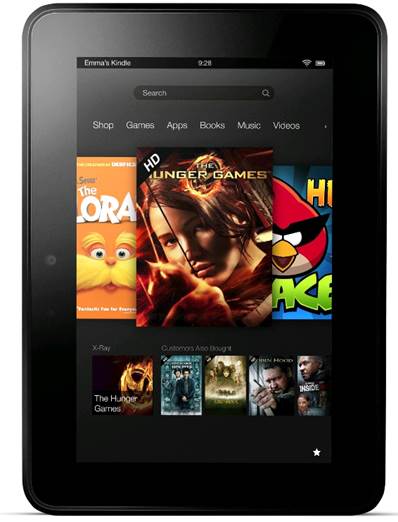
Amazon
Kindle Fire HD
Google Nexus 7
The Nexus is also reportedly selling
fairly well.There's no camera on the back, but it does have a front videoconferencing
camera and GPS. The Wi-Fi-only model starts at $199 for 16GB of memory. A
version that connects to the cellular data network starts at $299. It uses the
FISPA+ network offered by AT&T and T-Mobile. The screen resolution is 1280
x 800, like that of the Kindle Fire FID. The processor is quad core, making it
the speediest of the 7-inch tablets.
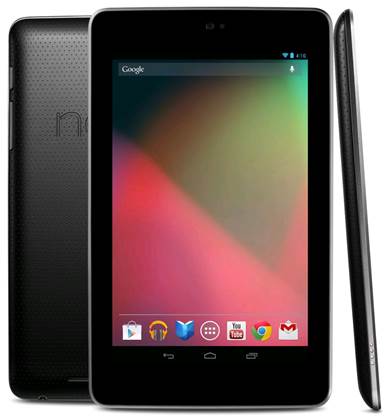
Google
Nexus 7
Barnes & Noble
Nook HD
This tablet has the best screen resolution
at 1440 x 900. The Nook FID starts at $199 with 8GB of memory; the 16GB model
is $229. At 0.7 lbs, it's almost as light as the iPad mini, and is lighter than
the Nexus 7 and Kindle Fire FID. Unlike the other tablets, it has a slot for a
microSD card, letting you expand the memory. There's no camera or GPS, and no
option for purchasing a model that connects to the cellular data network.
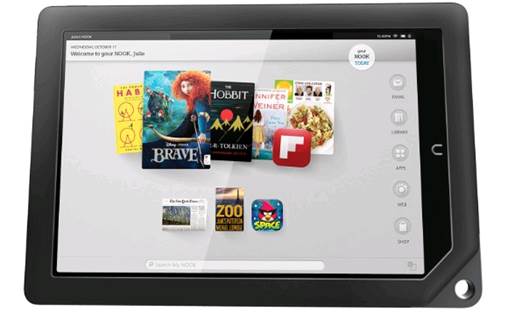
Barnes
& Noble Nook HD
Overall, I'm impressed with the options now
available. However, the most important consideration may not be the specs.
Here are other important factors:
Apps
There are over 275,000 apps designed
specifically for the iPad, whereas other tablets can boast only a fraction of
that. If you want to use your tablet as a computer, i.e., a powerful and
versatile tool for performing a wide range of functions, in my mind your only
choices are the iPad and the Google Nexus tablets. The Nexus runs Android, as
do the Kindle and Nook, but with a difference. You get pure Android on the
Nexus, not the modified version on the other devices. Not only does the Nexus
have the most apps available, it will also always be able to run the latest and
greatest version of Android. This is because it's sold by Google, who develops
Android. With other devices you have to wait until the latest version is made
available from the vendor, which can take a long time.
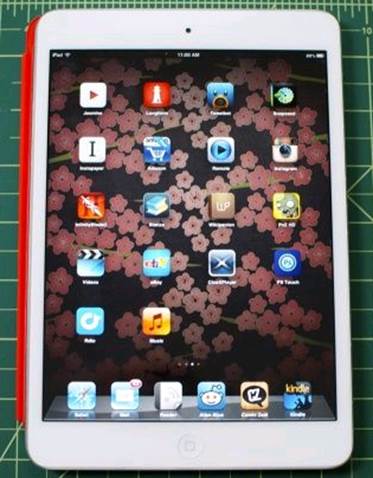
There
are over 275,000 apps designed specifically for the iPad.
Your Computing Environment
If you're an Apple user and already have a
lot of Apple Store media, or if you use Apple's email, contacts, and calendar
software, your best choice by far is the iPad. While I can use my Nexus just
fine to do my Apple email, there's no easy way to sync it with my Apple
calendar or contacts, a real deal-breaker for me. And it's difficult to convert
my Apple Store media for use on my Nexus. On the other hand, if you're a heavy
user of Google's computing environment, including Gmail, Google Calendar,
Google Contacts, and Google Docs, the Nexus may be a good choice.
Your Media Usage
If you want a tablet primarily for media
consumption, and not for taking photos, using GPS, using lots of apps, or
syncing with email and contacts, then the best choice may be the less expensive
tablets from Amazon and Barnes & Noble. The latter signed deals with the
major movie studios and beefed up its movie content last fall, and Amazon has
long had a wealth of content. If you're an Amazon Prime subscriber and do a lot
of shopping on Amazon, the Kindle Fire may be worth considering. It's a great
window into the Amazon experience. The Nexus 7, Kindle Fire FID, and Nook FID
all have an aspect ratio of 16:10, making them ideal for widescreen movies.
(The iPad's aspect ratio is 4:3.) Plus, they all have greater resolution than
the iPad mini, with the pixel density of the Nook almost on par with that of
the Retina-display iPads.
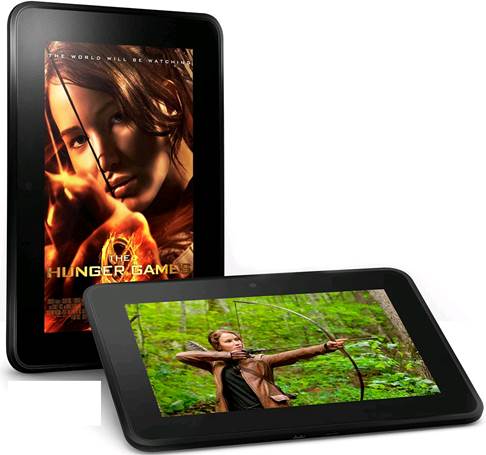
Amazon's
Kindle Fire HD might be worth considering if you want a less expensive tablet
to use primarily for media consumption.
Your Need for Mobility
As much as I like my Nexus 7, I use my iPad
mini almost exclusively, in part because I often want to use it when there's no
Wi-Fi signal nearby. I like the convenience of being able to connect to the
cell phone data network. If you have the same need as I do, that limits your
choices to the iPad or Nexus 7. The data plans range from $15 to $30 per month.
Or you can tack your data plan onto your cell phone plan for $10 per month.
Why I prefer the iPad mini
Screen Size
Although the iPad mini's screen, at 7.9
inches, sounds as if it’s nearly the same size as the other 7-inch tablets,
it's actually 35% larger. The Nexus 7, for example, uses up a small amount of
screen space for navigation icons. So when you're browsing the web with your
device oriented horizontally, the iPad mini actually has 65% more viewing
space. In my experience, this makes a big difference.
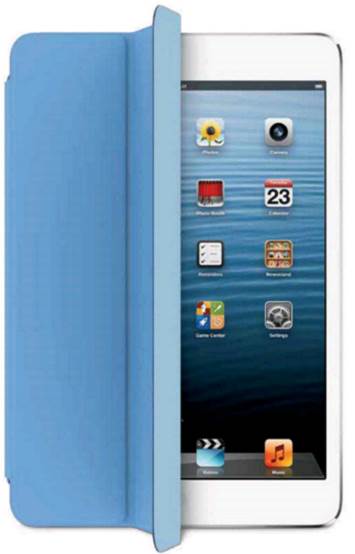
Although
the iPad mini's screen, at 7.9 inches, sounds as if it’s nearly the same size
as the other 7-inch tablets, it's actually 35% larger.
Aspect Ratio
I find that while the 16:10 aspect ratio of
the other tablets is good for watching movies, I much prefer the iPad mini's
shape for everything else. It has the same proportions as an 8.5 x 11- inch
sheet of paper, and it just seems more functional.
Cameras, GPS, and Cellular Data
Connectivity
I use all three of these features on my
iPad a lot, and I can't imagine having a tablet without these capabilities. But
it costs: you'll have to pay at least $459 for your iPad mini to have all
three, but to me it's worth it.
Apps
The selection of apps tailored to the
screen of the iPad mini will probably always be greater than that for Android
tablets. In the past, developers have complained about having to develop for
the wide range of screen sizes in Android devices. It's my guess that this
discrepancy will keep some developers away from creating Android-specific apps.
Syncing and iCIoud
I use Apples cloud services and prefer an
iPad because my media, calendar, contacts, notes, and email are always in sync.
It’s a huge convenience to be able to work on answering email when I’m out and
about and have all those changes automatically appear when I'm back at my
desktop computer.
Overall, I'm impressed with these
lower-priced tablets and feel that they all would make a good purchase,
depending on your needs. My first love is the iPad mini, but it's great to see
the competition getting stronger.